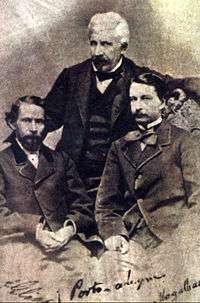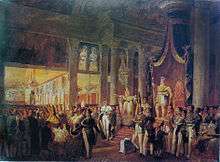Manuel de Araújo Porto-Alegre, Baron of Santo Ângelo
| Manuel de Araújo Porto-Alegre | |
|---|---|
|
Porto-Alegre in an 1869 painting by Pedro Américo | |
| Born |
Manuel José de Araújo Porto-Alegre November 29, 1806 Rio Pardo, Brazil |
| Died |
December 30, 1879 (aged 73) Lisbon, Portugal |
| Pen name | Tibúrcio do Amarante |
| Occupation | Writer, painter, caricaturist, professor, diplomat, architect |
| Nationality |
|
| Alma mater | Escola Nacional de Belas Artes |
| Period | 19th century |
| Genre | Poetry, theatre, painting, drawing, editorial cartoon |
| Literary movement | Romanticism |
| Spouse | Ana Paulina Delamare |
| Children | Carlota Porto-Alegre, Paulo Porto-Alegre |
Manuel José de Araújo Porto-Alegre, Baron of Santo Ângelo (November 29, 1806 – December 30, 1879), was a Brazilian Romantic writer, painter, architect, diplomat and professor, considered to be one of the first Brazilian editorial cartoonists ever. He is the patron of the 32nd chair of the Brazilian Academy of Letters.
Life
Porto-Alegre was born Manuel José de Araújo in Rio Pardo, Rio Grande do Sul, to Francisco José de Araújo and Francisca Antônia Viana. He would change his name to Manuel de Araújo Pitangueira during the independence of Brazil, due to nativist causes. Later on, he finally changed it to its definitive form: Manuel de Araújo Porto-Alegre.
In 1826, he moved to Rio de Janeiro, in order to study painting with Jean-Baptiste Debret at the Escola Nacional de Belas Artes (at the time called the Academia Imperial de Belas Artes). He also studied at what is now the Academia Militar das Agulhas Negras and took a Medicine course and Philosophy. In 1831, he left Brazil along with Debret to Europe, in order to improve his painting techniques. In 1835, he went to Italy, where he met Gonçalves de Magalhães, another Brazilian poet. He and Magalhães would create in France, in the year of 1837, a short-lived magazine named Niterói, alongside Francisco de Sales Torres Homem. Also in 1837, he becomes history painting teacher at the Escola Nacional de Belas Artes, in a post that would last until 1848, when he would become a drawing teacher at the Academia Militar das Agulhas Negras, and starts doing his first caricatures. In 1838, he married Ana Paulina Delamare, having with her two children: Carlota Porto-Alegre (the future wife of painter Pedro Américo) and future diplomat Paulo Porto-Alegre.

In 1840 he is named the official painter and decorator of Emperor Pedro II's palace. He decorated the imperial palace in Petrópolis, the wedding of Pedro II with Teresa Cristina of the Two Sicilies and the aforementioned emperor's coronation. He was decorated with the Order of Christ and the Order of the Rose.

Reuniting with Gonçalves de Magalhães and Torres Homem, he founded a periodic named Minerva Brasiliense, that lasted from 1843 to 1845. He would publish in this periodic his poem Brasiliana. In 1844, alongside Torres Homem, he founded the humoristic magazine Lanterna Mágica, where he published his caricatures.
In 1849, Porto-Alegre founded the magazine Guanabara, alongside Joaquim Manuel de Macedo and Gonçalves Dias. The magazine, considered the official journal of the Romantic movement in Brazil, lasted until 1856.
In 1852, he enters the political career, assuming a position as a substitute councilman in the Municipal Chamber of Rio de Janeiro, lending service in the areas of urbanism and public health. He would exerce this post until 1854, the year when he became the headmaster of the Escola Nacional de Belas Artes, lasting until 1857.
In 1860, Porto-Alegre entered the diplomatic career, where he served as the consul of Brazil in the Kingdom of Prussia, in the Kingdom of Saxony and later in Portugal, where he died. (Porto-Alegre's remains were brought to Brazil in 1922.)
He was proclaimed Baron of Santo Ângelo by Emperor Pedro II in 1874, and was a member of the Brazilian Historic and Geographic Institute.
Spiritism
While in Dresden in 1865, Porto-Alegre wrote a letter to Joaquim Manuel de Macedo, then-tutor of Princess Isabel's children, in which he reveals that he became a Spiritist and was able to psycograph messages from the Underworld, and Isabel would ask him "who was [her] guardian spirit". The letter, now being kept at the Brazilian National Archives, has 12 pages.[1]
Literary works
Poetry
- Ode Sáfica (1830 — dedicated to Jean-Baptiste Debret)
- Canto Inaugural (1855)
- Brasiliana (1863)
- Colombo (epic poem — 1866)

Theater plays
- Prólogo Dramático (1837)
- Angélica e Firmino (1845)
- A Destruição das Florestas (1845)
- A Estátua Amazônica (1851)
- A Restauração de Pernambuco (1852)
- A Noite de São João (1857)
- Cenas de Penafiel (1858)
- Os Judas (1859)
- O Prestígio da Lei (1859)
- Os Lobisomens (1862)
- Os Voluntários da Pátria (1877)
Fiction
- Excertos das Memórias e Viagens do Coronel Bonifácio do Amarante (under pen name Tibúrcio do Amarante) (1848)
Translations
- Electra by Euripides
- Lucrèce Borgia by Victor Hugo
- Christine of Sweden by Alexandre Dumas
Famous paintings
 Portrait of Pedro I of Brazil, oil painting
Portrait of Pedro I of Brazil, oil painting Brazilian Jungle, watercolor painting
Brazilian Jungle, watercolor painting Study for a Decorative Panel, oil and nankeen
Study for a Decorative Panel, oil and nankeen Pietà
Pietà Study for Pedro II's Sagration, oil painting
Study for Pedro II's Sagration, oil painting Self-portrait, oil painting; circa 1823
Self-portrait, oil painting; circa 1823 This caricature that satirizes the Regency period of the Empire of Brazil (1831–1840) was made by Porto-Alegre, and is considered to be the first Brazilian editorial cartoon ever
This caricature that satirizes the Regency period of the Empire of Brazil (1831–1840) was made by Porto-Alegre, and is considered to be the first Brazilian editorial cartoon ever
References
- ↑ Além da Vida magazine, 30th edition. Brazilian National Archives, Rio de Janeiro.
External links
| Wikimedia Commons has media related to Manoel de Araújo Porto-alegre. |
| Portuguese Wikisource has original text related to this article: |
- Excerpts of Porto-alegre's epic poem Colombo at the official site of the Brazilian Academy of Letters (Portuguese)
- Porto-Alegre's biography at the official site of the Brazilian Academy of Letters (Portuguese)
- A chronology of Porto-Alegre's life in Itaú Cultural (Portuguese)
| Preceded by New creation |
 Baron of Santo Ângelo 1874 — 1879 |
Succeeded by None |
| Preceded by New creation |
Brazilian Academy of Letters - Patron of the 32nd chair |
Succeeded by Carlos de Laet (founder) |

